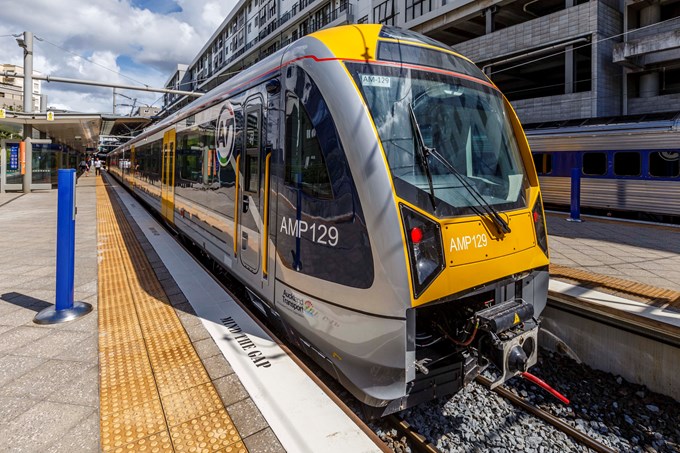(Corrects article published on 29 October 2015 to show the first stage of the Auckland-Manukau Eastern Transport Initiative cost $1.1 billion, not $1.5 billion as earlier stated.)
In the third part of our series, we look at some of Auckland Council's initiatives to help improve transport in the region.
Long ranked the region’s number one issue, transport has remained top priority in the first five years of Auckland Council.
“Fix transport” was the overriding message from the public through consultation around the Auckland Plan and other high-level roadmaps to solving the most pressing problems and becoming the world’s most liveable city.
Aucklanders made it clear we needed to invest in major infrastructure and systems so that ultimately they could use and enjoy transport options offering real alternatives.
The new Auckland is all about providing our people with options other than their car – trains, buses, ferries, cycling and walking – with light rail on the horizon,” says Auckland Mayor Len Brown.
“At the heart of all that is the City Rail Link (CRL). The CRL will be a prime feature of Auckland Council’s next five years – that’s how long it’s expected to take to build, at an estimated $2.4 billion.”
Auckland Transport (AT) came into effect at the same time as the council on 1 November 2010. It was set up as a council-controlled organisation dedicated to an integrated approach to the region’s transport strategy and operations.
Since 2010, $3.7 billion has been spent on new infrastructure and renewals, such as roads, rail stations, wharves and transport interchanges. These projects are designed to cater for the forecasted hikes in population, which will also ramp up the demand for freight and commercial trips to double the current level.
Public transport on the rise
Providing alternatives to Aucklanders to using their private cars has been an essential complement to the physical improvements. We’ve prioritised a new integrated public transport system and programmes encouraging people to change their travel habits.
As a result, passenger patronage on public transport has risen from 60 million trips in 2010 to 80 million as at August 2015, exceeding the targets across bus, trains and ferries. The latest figures are significant as they cover the first period when the Western, Southern, Eastern and Onehunga lines were all using the electric trains.
Key achievements that are helping to improve the public transport experience for Aucklanders include:
- bringing 57 new electric trains into service, having completed the $1.5 billion double tracking, station upgrades and electrification of the rail network
- establishing integrated ‘touch-ticketing’ across all public transport, with the introduction of the AT HOP card
- redesigning bus and ferry networks to integrate with the rail system, while express busways and bus lanes now connect areas not yet serviced by rail.
City Rail Link progress
- Enabling works begin on the City Rail Link in 2015 that will enhance the city centre’s economic potential and enable faster and more frequent trips across the network.
- Building the new 3.4km tunnel will turn Britomart from an end-point to a through-station, freeing up capacity constraints and connecting Britomart to the North Auckland Line near Mt Eden Station. Two new city stations will be added at Aotea Centre and Karangahape Road.
- The CRL will be a prime feature of Auckland Council’s next five years – as it will be under construction all this time, at an estimated $2.5 billion.
Unlocking east and west
In the east of the city, a major milestone was reached in 2014/2015 with the first-stage completion of the Auckland-Manukau Eastern Transport Initiative (AMETI), a $1.1 billion (total) package of projects aimed at giving residents of the eastern suburbs greater transport choices and better connecting them to the rest of Auckland.
The first stage of AMETI is the largest Auckland Transport construction project completed to date. Stage One included a new Panmure train and bus station, new Ellerslie-Panmure Highway bridges, along with Te Horeta Road linking Glen Innes and Mt Wellington, designed to take 20,000 vehicles off the route through Panmure roundabout and local roads.
It is already having benefits, with a 121 per cent increase in passenger boardings at Panmure Station in the year to June 2015 and reduced traffic through Panmure roundabout.
Consent applications will be made soon for Stage Two, which will replace Panmure roundabout with an intersection, build a new South Eastern Busway linking Panmure Station with Pakuranga and create new cycle and pedestrian links between the two town centres.
In Auckland’s west, the continued revitalisation of New Lynn’s town centre has been a great example of how the location, type and timing of transport infrastructure can help shape urban development and improve liveability in areas marked for growth.
After a new rail station was completed in 2010, we followed up with a number of other improvements, including:
- Clark Street bypass, which re-routed heavy vehicles
- new shared spaces in McCrae Way and Totara Avenue
- a transit-oriented development on the old bus station site, with better access to public transport.
Shared space success
Shared spaces like the ones in New Lynn are also proving successful elsewhere in the region, where they’re playing their part in a network of safe walkways and cycle lanes aimed at getting people out of their cars.
These spaces allow traffic to operate safely and at low speed around people activities such as walking, cycling and shopping. After the Darby, Lorne and Fort street spaces were introduced, pedestrian activity increased by between 50 and 140 per cent.
Just in the past financial year, we completed the country’s first on-road, separated urban cycleway along Beach Road, linking the city centre to the north-western cycleway, and the first stage of the Westhaven Promenade with walkways, cycleways and boardwalks.
Auckland Council, Auckland Transport and the NZ Transport Agency are working on a $200 million, three-year programme of cycle projects that will make getting around Auckland by bike safer and easier.
Read more about the region’s cycle initiatives.


